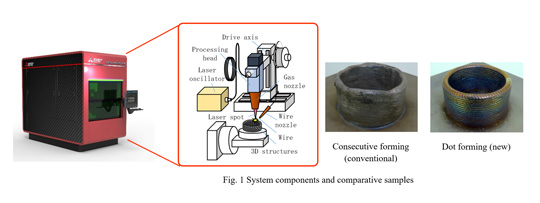As the advancement and adoption of 3D printing technology continues to grow on all fronts, some of the world’s leading tech-minded titans are looking to get their own piece of the additive manufacturing pie. The latest company to enter the market is the Japanese electronics manufacturer Mitsubishi Electric Corporation, which has just announced the development of a new metal 3D printing system.
The process is described as a “unique dot forming technology,” merging together laser, CNC, and CAM technologies to produce high-quality metal parts with high precision and at a very fast speed. This technology utilizes laser wire directed energy deposition to fuse metal wire as the material is deposited.
Focused thermal energy is used to fuse the metal wire, ensuring that high temperature is only applied to a precise spot on the build area. As a result, the dot forming technology effectively reduces the risk of oxidization by over 20 percent. According to Mitsubishi Electric, the technique is able to achieve advantages that are comparable to powder-based metal 3D printing systems. The primary benefit of this newly developed process is that it eliminates the risk of voids forming in parts, which in turn enables the production of dense objects at an incredibly fast pace.

Mitsubishi Enters the 3D Printing Game From Multiple Angles
Taking a piece out of the CNC machining playbook, this distinct metal 3D printing system is integrated with a pulsed laser and minimized heat input. This ensures that there is enough cooling time between when the wire is melted. Without these CNC-inspired attributes, the laser would be continuously irradiated, which in turn increases the temperature of the deposition base. If the molten metal wire is deposited onto the still-hot base, the part will take more time to solidify and could potentially end up collapsing under its own weight.
Thanks to the unique process created by Mitsubishi Electric, this additive manufacturing system is capable of producing parts with hollow or overhanging geometries. Since it’s compatible with a wide array of readily available laser-welding wire materials, manufacturers will be able to keep costs down. These materials are also more environmentally sustainable than traditional metal powders.
With Mitsubishi’s dot forming technology, users will be able to synchronously control the pulsed laser irradiation, the supply of metal and shield gas, and shaping position all at the same time. This helps the metal 3D printing system achieve accuracies that are 60 percent more precise than traditional constructive forming technology.
Another notable benefit of Mitsubishi’s dot forming technology is that the pulsed laser irradiation, the supply of metal and shield gas and shaping position can all be controlled synchronously. This allows for shape accuracies 60% more precise than more traditional consecutive forming technology and reduces the risk of shape collapse.
Considering the Mitsubishi is also a leading car manufacturer, it’s no surprise that its new metal additive manufacturing technology is designed to produce near-net parts for the automotive and aerospace industries. Meanwhile, Mitsubishi Chemical Group is working on innovations for the material-side of 3D printing, recently partnering with companies like Ultimaker and Verbatim to produce advanced materials for FDM 3D printing.
Mitsubishi Electric will be showcasing the technology at this year’s Japan International Machine Tool Fair, while the platform is scheduled to launch sometime in 2021.
License: The text of "Mitsubishi Enters the Metal 3D Printing Market with New Additive Manufacturing System" by All3DP is licensed under a Creative Commons Attribution 4.0 International License.